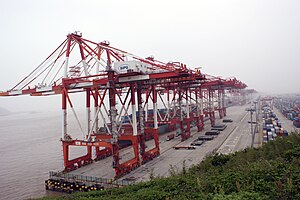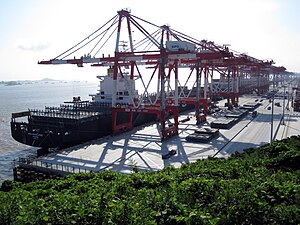Parts of this article (those related to Some sources are unavailable, lots of errors and poorly written sentences.) need to be updated. (April 2021) |
The Port of Shanghai (Chinese: 上海港; pinyin: Shànghǎi Gǎng ; Wu; Zånhae Kån) is located in the vicinity of Shanghai, comprises a deep-sea port and a river port.
| Port of Shanghai 上海港 | |
|---|---|
 Yangshan Deep-water Port | |
 Click on the map for a fullscreen view | |
| Location | |
| Country | People's Republic of China |
| Location | Shanghai |
| Coordinates | 30°37′36″N 122°03′54″E / 30.626539°N 122.064958°E |
| Details | |
| Opened | 1842 (As treaty port) |
| Operated by | Shanghai International Port Company Ltd. |
| Owned by | Public |
| Type of harbour | Deep-water seaport/Riverport |
| Statistics | |
| Annual cargo tonnage | 514 million (2016) |
| Annual container volume | 43.3 million TEU (2019) |
| Website portshanghai.com.cn | |


The main port enterprise in Shanghai, the Shanghai International Port Group (SIPG), was established during the reconstitution of the Shanghai Port Authority. Companies such as the Shanghai Port Container Co. and Waigaoqiao Bonded Zone Port Co. were involved in port of Shanghai.[1]
In 2010, Shanghai port overtook the Port of Singapore to become the world's busiest container port. Shanghai's port handled 29.05 million TEU, whereas Singapore's was a half million TEU behind.[2][3] Shanghai handled 43.3 million TEU in 2019.[4]
Shanghai is one of only four port-cities in the world to be categorised as a large-port Megacity, due to its high volumes of port traffic and large urban population.[5]
Geography
editThe Port of Shanghai faces the East China Sea to the east and Hangzhou Bay to the south. It includes the confluences of the Yangtze River, Huangpu River (which enters the Yangtze River) and Qiantang River.
Administration
editThe Port of Shanghai is managed by Shanghai International Port, which superseded the Shanghai Port Authority in 2003.[6] Shanghai International Port Company Limited is a public listed company, of which the Shanghai Municipal Government owns 44% of the outstanding shares.[6]
History
editIn 1842, Shanghai became a treaty port, thus developing into an international commercial city. By the early 20th century, it was the largest city and the largest port in East Asia. In 1949, with the Communist takeover in Shanghai, overseas trade was cut dramatically. The economic policy of the People's Republic had a crippling effect on Shanghai's infrastructure and capital development.
In 1991, the central government allowed Shanghai to initiate economic reform. Since then, the port has developed at a rapid pace. By 2005, the Yangshan deep-water port had been built on the Yangshan islands, a group of islands in Hangzhou Bay linked to Shanghai by the Donghai Bridge. This development allowed the port to overcome shallow water conditions in its current location and to rival another deep-water port, the nearby Port of Ningbo-Zhoushan.
The port is part of the 21st Century Maritime Silk Road that runs from the Chinese coast to Singapore, towards the southern tip of India to Mombasa, from there through the Red Sea via the Suez Canal to the Mediterranean, there to the Upper Adriatic region to the northern Italian hub of Trieste with its connections to Central Europe and the North Sea.[7][8][9][10]
Harbour zones
editThe port of Shanghai includes three major working zones:
Economy
editThe Port of Shanghai is a critically important transport hub for the Yangtze River region and the most important gateway for foreign trade. It serves the Yangtze economically developed hinterland of Anhui, Jiangsu, Zhejiang and Henan provinces with its dense population, strong industrial base and developed agricultural sector.[11]
Data
editSee also
editReferences
edit- ^ Cullinane, Kevin; Teng, Yahui; Wang, Teng-Fei (2005-10-01). "Port competition between Shanghai and Ningbo". Maritime Policy & Management. 32 (4): 331–346. doi:10.1080/03088830500300438. ISSN 0308-8839. S2CID 153641988. Archived from the original on 2023-11-13. Retrieved 2020-11-29.
- ^ "Shanghai overtakes S'pore as world's busiest port". Straits Times. 8 January 2011. Archived from the original on 2011-08-15. Retrieved 2011-09-14.
- ^ "Statistics". www.iaphworldports.org. Archived from the original on 2015-10-04. Retrieved 2015-10-03.
- ^ "Safety4Sea". Safety4sea. IHS. Archived from the original on 14 June 2021. Retrieved 29 May 2020.
- ^ Roberts, Toby; Williams, Ian; Preston, John (2020). "The Southampton system: A new universal standard approach for port-city classification". Maritime Policy & Management. 48 (4): 1–13. doi:10.1080/03088839.2020.1802785.
- ^ Jump up to: a b "About SIPG". Shanghai International Port (Group) Co., Ltd. Archived from the original on 2010-01-13. Retrieved 2010-03-20.
- ^ Marcus Hernig: Die Renaissance der Seidenstraße (2018) pp 112.
- ^ "Can the New Silk Road Compete with the Maritime Silk Road?". Archived from the original on 2021-04-20. Retrieved 2021-01-24.
- ^ "China's Maritime Silk Road and the Middle East: Tacking Against the Wind". Archived from the original on 2021-01-21. Retrieved 2021-01-24.
- ^ Bao Jianga, Jian Lib, Chunxia Gong "Maritime Shipping and Export Trade on “Maritime Silk Road”" In: The Asian Journal of Shipping and Logistics, Volume 34, Issue 2, June 2018, Pages 83-90.
- ^ "About Port of Shanghai". Shanghai International Port (Group) Co., Ltd. Archived from the original on 2017-06-08. Retrieved 2010-03-20.
- ^ http://www.ship-technology.com/projects/portofshnaghai/ Archived 2023-05-28 at the Wayback Machine Port of Shanghai, China
- ^ "Top 15 Largest Seaports of the World". GeoHive. Archived from the original on 2013-01-27. Retrieved 2012-12-18.
